Seven Leaders Join Valley Vision Board in 2021
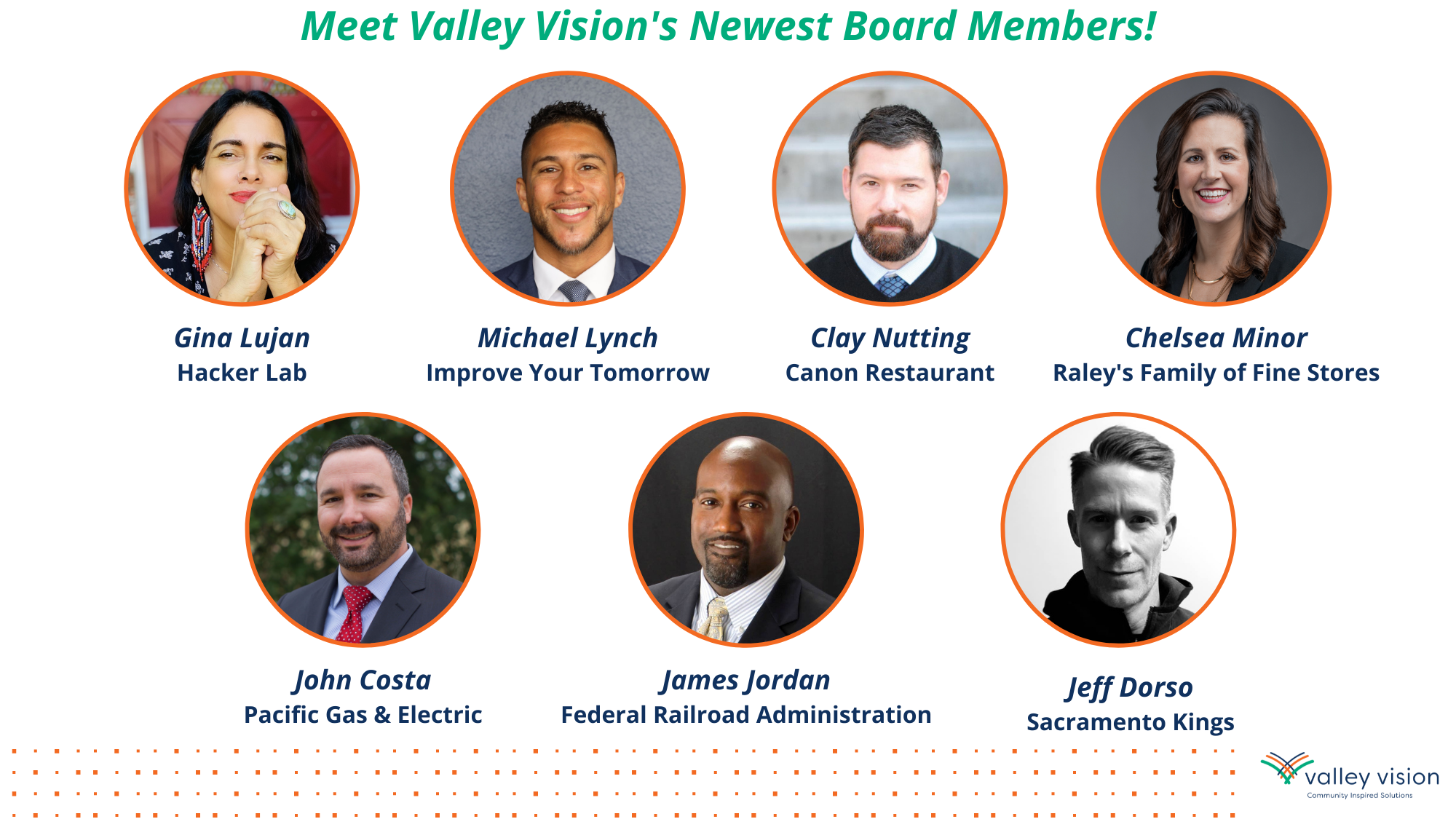
I am thrilled to share the news that seven truly outstanding local leaders have joined our organization’s Board of Directors in recent months, each who uniquely compliments Valley Vision’s core focus areas of workforce, innovation, food systems, civic engagement, and healthy communities. These individuals join an already impressive slate of directors who are committed to helping build a better future for our region.
Valley Vision is a unique organization with a special purpose: to make our communities the most livable in the nation. That’s why our board is composed of a diverse set of dynamic leaders who rely on Valley Vision’s independent research to identify current and future opportunities and to help solve complicated issues affecting quality of life through regional action. Their priority is to place the region’s future first and I am pleased to introduce you to them.

Meet Valley Vision’s 2021 slate of board members:
Chelsea Minor is Corporate Director of Public Affairs for Raley’s, an innovative, regional, family-owned grocery chain with stores founded and headquartered in Sacramento that operates stores across Northern California and Nevada. Chelsea is Raley’s lead spokesperson and oversees the company’s public affairs and brand reputation strategies. Her breadth of knowledge and industry connections will be instrumental in guiding Valley Vision’s important work in the food system space.
Clay Nutting is the owner and operator of Canon, among only a small handful of local restaurants recognized last year in California’s Michelin Guide. Clay co-founded a grassroots effort called Family Meal at the onset of the pandemic, which involved over two-dozen local and independent restaurants that provided over 250,000 meals to vulnerable residents across Sacramento County. His efforts in the community centered on food insecurity are tightly aligned with Valley Vision’s food insecurity and food equity strategies.
Gina Lujan is a social entrepreneur with 28 years of experience focused on building community, business development, innovation, strategy, and economic development. She co-founded Sacramento’s Hacker Lab in 2012, one of the city’s first local maker and coworking spaces that supports innovation through community-driven education and maintains a commitment to tangible access for all. Gina’s energetic entrepreneurial spirit and passion for education, opportunity, and advancement within underserved communities gives Valley Vision’s board a means for broader conversations and planning for strategies that support vulnerable populations.
James Jordan is a seasoned public service leader with a career in the transportation industry that spans over 25 years. He currently serves in the Federal Railroad Administration as Railroad Administrator and is responsible for the safety and operational oversight for every commuter railway located west of the Mississippi River. As an integral leader in the FRA, James works with the US Department of Transportation to promote and enforce safety throughout the U.S., including the rehabilitation of rail passenger services, supporting research and development, and advancing transportation for passengers and the general public. James’ boundary-breaking leadership at the FRA as well as his long-term commitment to the Sacramento region will support Valley Vision’s mission of equity, prosperity, and sustainability.
Jeff Dorso is the Senior Vice President and General Counsel for the Sacramento Kings, overseeing all legal and real estate development-related matters for the Sacramento Kings and its related companies, including the LEED Platinum Golden 1 Center, all real estate and media holdings, Sacramento Kings Guard (the NBA 2K eSports team), the Sacramento Kings Foundation, and the Stockton Kings (the NBA G League team). Jeff’s leadership in shaping development in Sacramento as well as his action-oriented mindset will help push Valley Vision towards effective and responsive action that supports the prosperity of our region.
John Costa, Senior Manager of Government Relations & Local Public Affairs for Pacific Gas & Electric (PG&E) Company in Northern California, works with community leaders and organizations throughout California, supporting PG&E lines of business and overseeing the day-to-day operations of various projects and company initiatives. John’s long history of engagement with government agencies and community based organizations as well as his commitment to healthy and sustainable communities will help Valley Vision support clean and sustainable communities for our region.
Michael Lynch, Co-Founder and Chief Executive Officer of Improve Your Tomorrow, is a social entrepreneur and certified professional fundraiser. As Valley Vision continues to seek workforce development solutions that answer a growing inequity gap across our most vulnerable communities, Michael’s work to improve academic outcomes for “at-promise” young people and transform systems that have historically failed communities of color will be especially valuable.
To keep up with Valley Vision’s work to advance livability in the Sacramento region, subscribe to our Vantage Point email newsletter!
Evan Schmidt is Valley Vision’s Chief Executive Officer.
Investing In Our Region
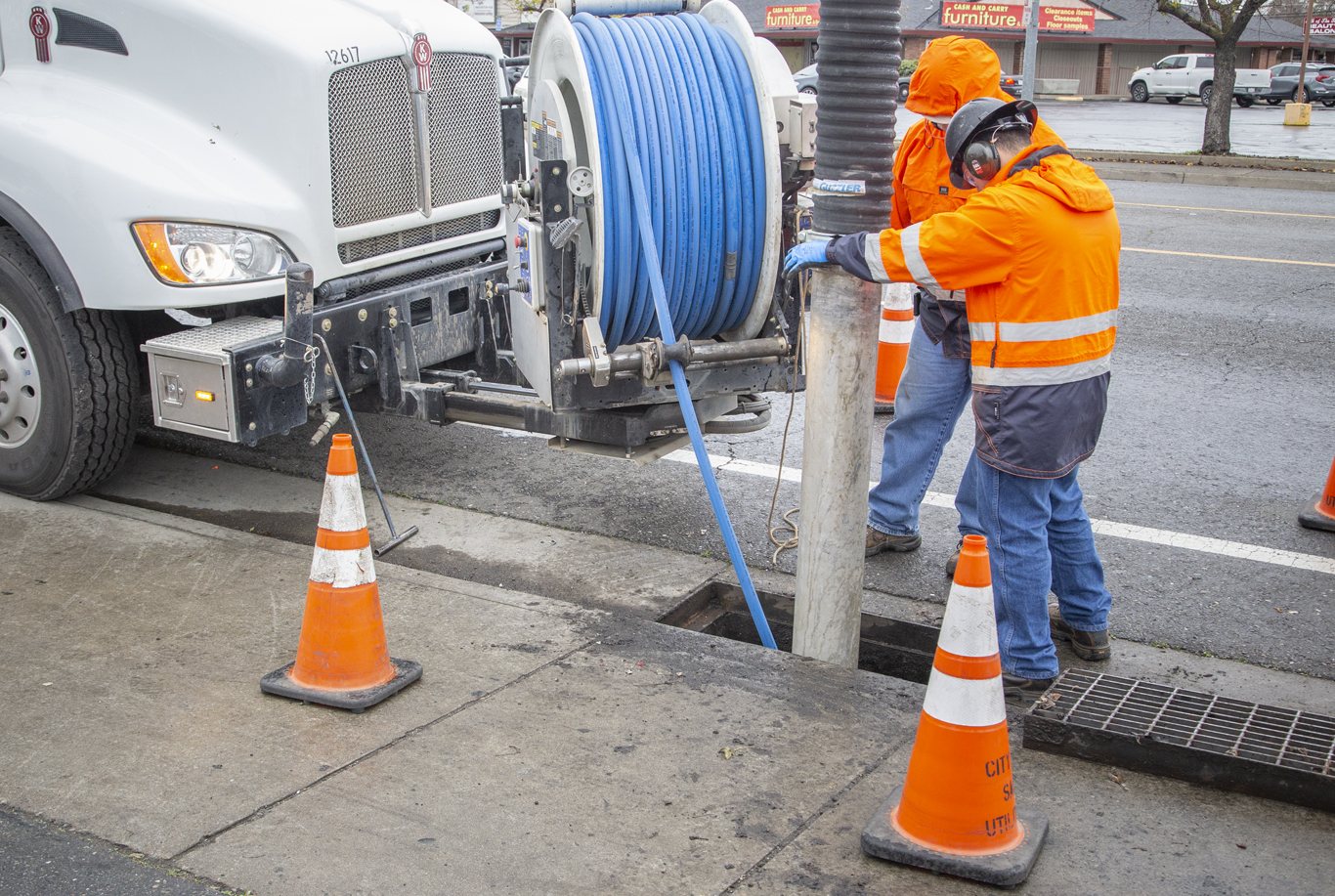
New, historic investments in regional economic recovery present our region with the opportunity to rebuild and grow, with a commitment to community and equity at the center of it. What have we done, and what must we do to take advantage?
This summer, we are seeing historic financial commitments to infrastructure, economic, environmental, and community resilience through both state and federal government channels. Just yesterday, the U.S. Senate passed a $1 trillion dollar infrastructure bill that will support expanded high speed internet access, roads, bridges, airports, Amtrak, and more. This will be the largest infusion of infrastructure investments in more than a decade and will certainly be felt within our region as those dollars get deployed across the country. In addition to infrastructure dollars, we have seen a significant commitment to recovery and community investment from both the Coronavirus Aid, Relief, and Economic Security Act (CARES), starting in 2020, and the American Rescue Plan Act (ARPA), passed in February 2021. The ARPA funds, which are just beginning to be deployed, will be used to meet pandemic response needs and rebuild a stronger, and more equitable economy as the country recovers. One example includes the Homeless Master Siting Plan that the City of Sacramento passed on Tuesday night, which will use $100 million in ARPA funds. We are seeing other ways the funds will be deployed including the Economic Development Administration’s recent release of a series of Notices of Funding Availability directed towards regional economic recovery.
In addition to these significant federal commitments, we are also seeing state investment opportunities. The state of California boasted an astonishing $75 billion budget surplus and, as a result, the 2021-22 California state budget and new recovery programs provide abundant opportunities for critical infrastructure improvements as well as needed community and regional recovery initiatives. For example, in late July, Governor Newsom made a $6 billion commitment to equitable and affordable access to broadband, providing needed dollars to close infrastructure and affordability gaps in underserved areas throughout the state. Additionally, the budget includes $3.7 billion for climate resilience, $600 million for inclusive regional economic development in a pending trailer bill, $1 billion for wildfire prevention and response, and $1 billion for workforce development statewide, to name just a few programmatic investments.

What does all this mean for our region? It means that we have the opportunity for big regional initiatives and bold, ambitious, and achievable goals. Luckily, we aren’t starting from scratch. We already have a roadmap for inclusive economic growth and an approved Comprehensive Economic Development Strategy in the Prosperity Strategy. We have bodies like the Capital Region Climate Readiness Collaborative, the Cleaner Air Partnership, the Connected Capital Area Broadband Consortium, the Sacramento Coalition for Digital Inclusion and many other regional and localized collaborative bodies who are shaping priorities and ideas for regional initiatives.
As we bring these investments into our region, we must all be committed to ensuring it is used to advance access to opportunity for all – particularly our neighborhoods and communities that have too often been overlooked. The rising tide must lift ALL boats. This is the time to build on our existing frameworks with additional inclusive, collaborative, and equity-centered planning to achieve bold, moonshot goals. What is your vision for a resilient, prosperous, equitable, and sustainable future for our region? Let’s work together to create impactful and bold initiatives that will serve our region and communities now and for generations to come. Contact us with any ideas or to stay engaged.
To keep up with Valley Vision’s work to advance livability in the Sacramento region, subscribe to our Vantage Point email newsletter!
Evan Schmidt is Valley Vision’s Chief Executive Officer.
Recap: Challenges and Opportunities in Our Region’s Food System
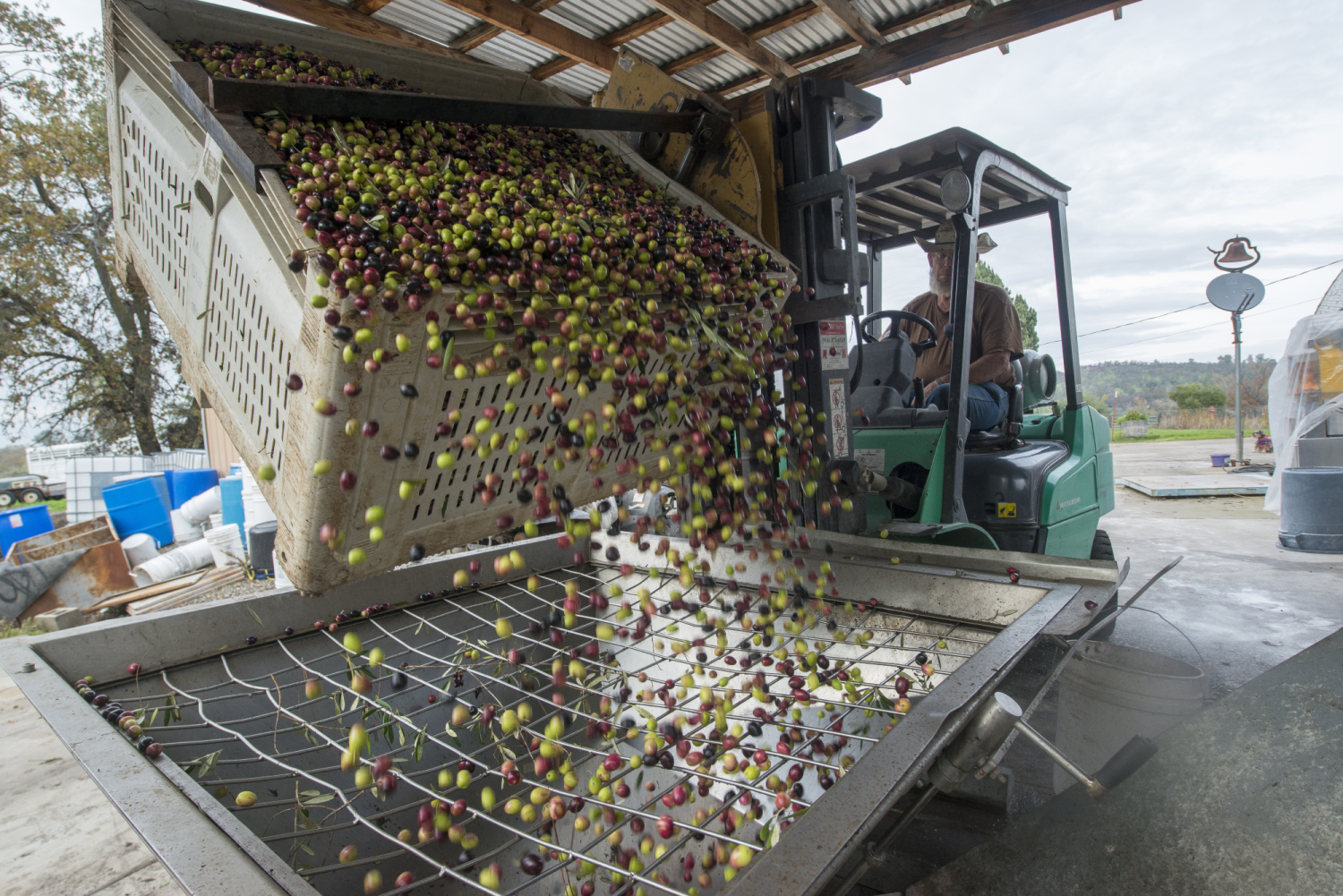
Valley Vision is proud to be researching and working alongside partners to support investment in the region’s food system.
Last month, as part of the 2021 Food System Action Plan update, Valley Vision hosted a series of Listening Sessions in topical areas as an opportunity to identify funding, capacity, and resource needs in the region’s Food System. We were joined by almost 200 participants who shared their expertise in workforce development and career pathways; viability of agriculture and land preservation; environmental sustainability and climate change; health and nutrition education; healthy food access and food security; and food economy and local market development.
Supported by the Sacramento Region Community Foundation, the 2021 Food System Action Plan (FSAP) is a regional food system investment strategy that will identify best practices, priorities, prevailing challenges, opportunities, and funding recommendations related to the region’s food system for the communities of El Dorado, Placer, Sacramento, and Yolo Counties. The goal is to increase the vitality of the region’s food system and to identify financing strategies and mechanisms to support a more equitable, health-promoting and accessible food system for all residents of the Greater Sacramento Region. The report will be released this Fall, and excitingly, for the first time, the report will be paired with a Food System Resilience Poll, in partnership with the Sacramento State Institute for Social Research (ISR) and Capital Public Radio. The poll covers similar topics related to the food system and will inform the Food System Action Plan. Both of these reports are slated to be released in Fall 2021.
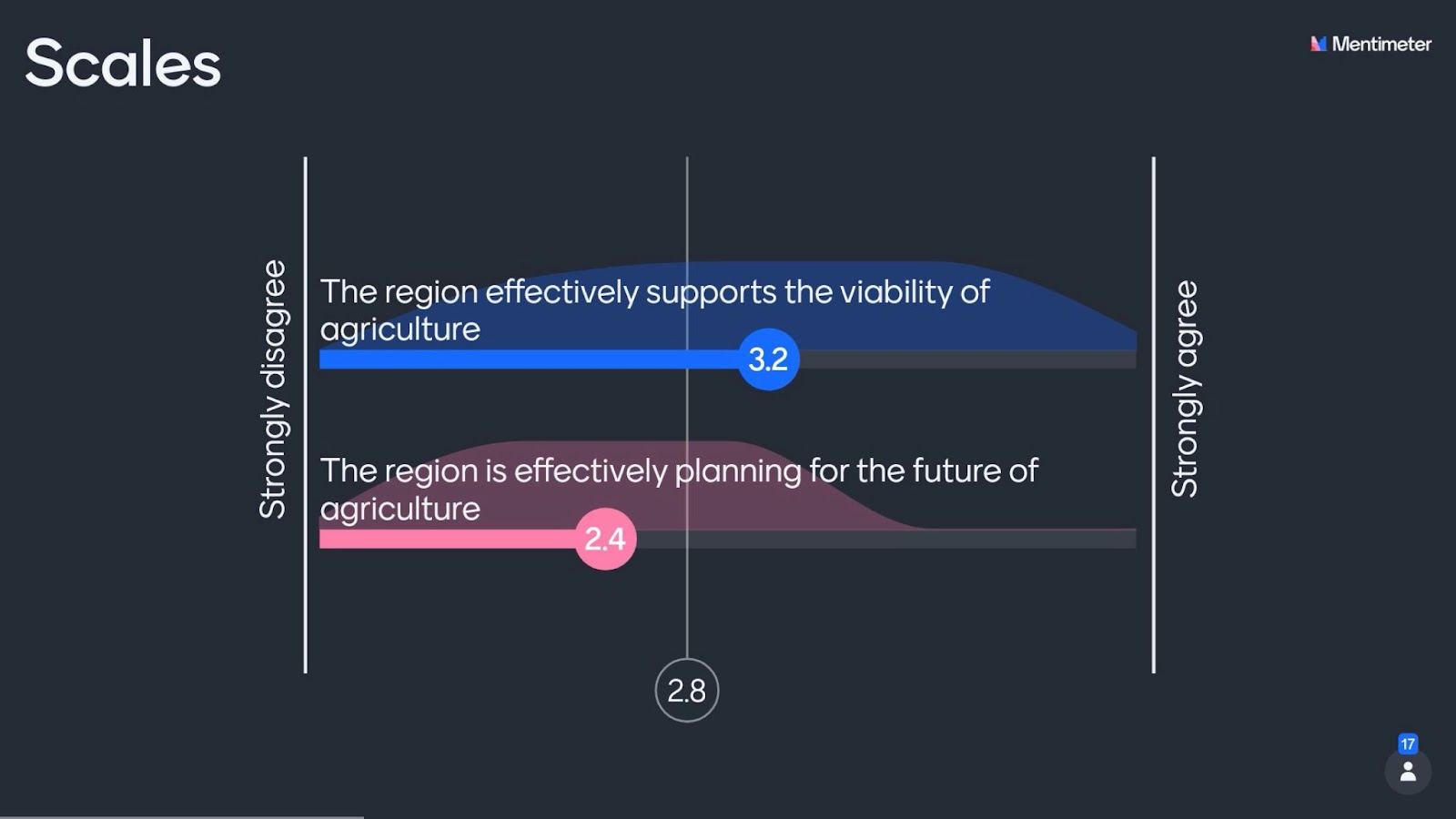
If you weren’t able to attend the listening sessions, below is a brief summary of each session:
- Session #1: The participants in the Careers in Food and Agriculture session discussed the manufacturing, processing, and distribution networks of the food system, illustrating the diversity of farm operations in the region. Although the session reminded us that the region has many successful Career Technical Education (CTE) programs in food and agriculture-which prepare high school students for college – challenges remain in sustaining, building, and retaining a local workforce, including the next generation of farmers and food producers. Lack of awareness of workforce opportunities and less than positive image were also challenges.
- Session #2: Land, capital and broadband access, agriculture technology, local markets, and land preservation were constant themes in the Viability of Agriculture session. Despite land conversion being a threat to agriculture’s viability, our region is doing better than others in the state; however, access to land to start a farm or a community garden remains a challenge. Workforce is another challenge.
- Session #3: During the Environmental Sustainability session, participants discussed local food production, food waste, edible food recovery, and the impacts climate change has had (and will have) on the food system, as is manifesting now. Although food hubs were discussed in some fashion in every session, in this session they were discussed extensively as a mechanism to reduce greenhouse gas emissions associated with transportation of produce and international trade and to provide additional capacity for packaging, processing and distribution of local produce for local consumption.
- Session #4: The Healthy Food Access and Food Security session showcased the strong network of nonprofits in the region, especially those in the emergency food system, who work to provide access to fresh, local, and nutritious food to under-resourced communities. In spite of the increased impact on this sector due to the pandemic, participants shared that consistent and expanded funding for infrastructure, organizational capacity and growth to manage the increased levels of clients and food remains a challenge.
- Session #5: In the Health and Nutrition session, the importance of family-based nutrition education and supply chain awareness was emphasized. A number of participants mentioned that most people are not aware of the correlation between food, health, and eating habits, and that robust educational support is needed to help promote healthy eating and nutrition literacy.
- Session #6: The Food Economy session focused on institutional purchases, entrepreneurship support, and local procurement partnerships. There are a significant number of small farmers in the region, but corporate producers can produce food for a lower price, making local food procurement and local economic development challenging. There are innovative efforts through schools and hospitals that can be models for increased local procurement and purchasing partnerships, support local producers and keep more dollars local.
The listening sessions revealed what most of us already know: As America’s Farm-to-Fork Capital, we have a lot of work to do but we have the infrastructure and the strong networks to do it. If we are organized as a region, we can better promote, support, and partner with one another to bring additional funding to the region. We look forward to sharing additional challenges, opportunities, and funding recommendations in the Fall when we release the 2021 Food System Action Plan.
The full recordings and presentation slides are available on Valley Vision’s website. If you weren’t able to attend the sessions and would like to provide comments for the FSAP, we have created a survey to gather additional input. Please reach out to Grace Kaufman (Grace.Kaufman@valleyvision.org) should you have any questions.
To keep up with Valley Vision’s work to advance livability in the Sacramento region, subscribe to our monthly Food and Ag newsletter!
Grace Kaufman is a Valley Vision Project Manager working in the Food and Ag and Clean Economy impact areas
A Broader Vision: Road Tripping Across America

Bigger rivers. The world’s largest Viking statue. The best mac and cheese I’ve ever had. A problematic coolant leak. All of these experiences and more contributed to an amazing 41-day road trip with my partner in June and July of 2021. It also brought a new perspective to my work at Valley Vision as l celebrated my seven-year anniVVersary last week (how time flies!).
Road trips are an American tradition – aligning the freedom of the automobile with the exploration of our country’s vast open spaces, beautiful national parks and forests, and distinct urban centers. For most of us mere mortals, our lives are largely confined to the physical spaces in which we live and work. So, to access a wider vision of our world by seeing the country – and a great deal of its nooks and crannies which you can only access by car – is a deeply rewarding experience. After a year of global trauma and emotional exhaustion resulting from the COVID-19 pandemic, this trip, for me, was sorely needed.
At Valley Vision, we’re focused on improving quality of life in our own Sacramento region, but we have also been at the center of important statewide projects like the Listos California Emergency Preparedness Campaign, and statewide leadership networks like the CA Stewardship Network. To learn from other regions, and to see their approaches to problem-solving firsthand, is a deeply valuable practice as we seek to improve our own region. Many of our local chambers of commerce organize ‘Study Missions’ to visit and learn from places elsewhere in the country just for this reason (one of which I was privileged to participate in back in 2018). So I took that line of thinking on the road with me and applied it as I explored other communities across the nation.
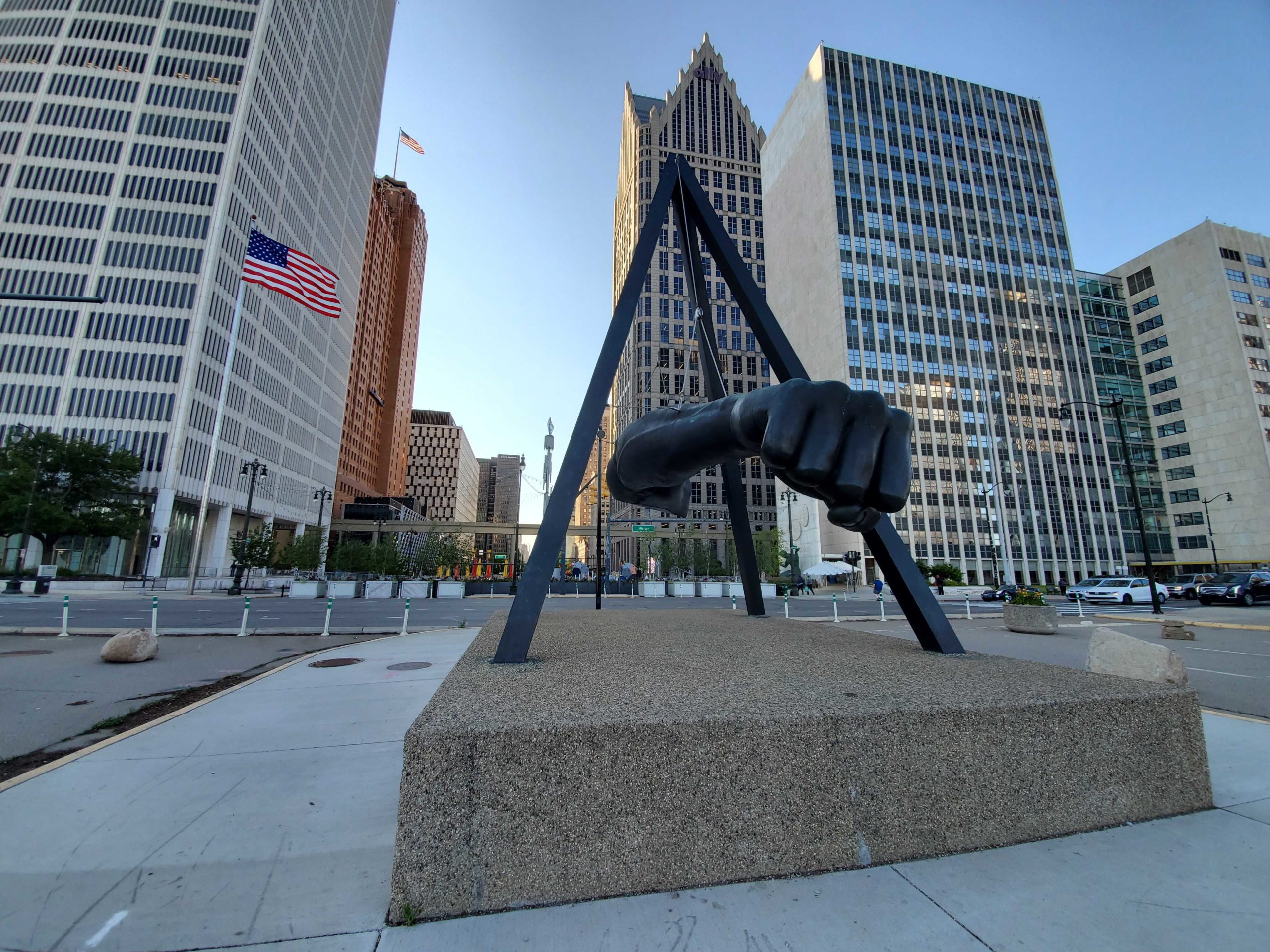
I committed to work remotely while on the road roughly half-time, continuing to move projects forward, participate in calls and meetings, and build the biweekly ‘Vantage Point’ email newsletter that people know and love. Cell coverage was sometimes more spotty than expected, accounting for time changes was a fun brain game, and coffee shops were a godsend (quite literally in one case, when a Christian coffee shop in Billings, MT allowed me to use their state-of-the-art conference room to facilitate the June Cleaner Air Partnership Luncheon on the day I was traveling from North Dakota to Yellowstone).
We spent time in a number of great places during our time on the road, and had very little “rest” time. I made it a point to explore the approaches to urbanism in each of these places, including architecture, use of space, and intangibles like the “energy” of a place. Checking out key landmarks was also a priority, such as ‘Tech Square’ in Atlanta, which Sacramento’s ‘Aggie Square’ is modeled on, or San Antonio’s famous River Walk, a world-class riverfront attraction. These small-scale ‘Study Missions’ exemplified the spirit of Valley Vision – to investigate and learn, but to have fun doing it.

We drove my trusty 2006 Honda Odyssey, which ran great until we hit Yellowstone. A coolant leak had me filling up the radiator with antifreeze and water every couple of hours for several days of touring Yellowstone, to avoid an overheated engine. I am convinced that a marmot or chipmunk chewed the water pump cable – an occurrence some high-elevation backpackers are familiar with. It was very nerve-racking to drive with an eye on the temperature gauge, and we eventually had to get it repaired in Spokane, WA before being on our way. My advice: check your fluids! And AAA, I learned the hard way, doesn’t provide roadside services in National Parks. We spent nights in the following places, either in a hostel, Airbnb, camping, or “boondocking” (sleeping in my van in a national forest or legal parking area), and the order of the list aligns with our route:
- Las Vegas/Red Rock Canyon
- Flagstaff/Grand Canyon
- Santa Fe
- San Antonio
- New Orleans/Atchafalaya National Wildlife Refuge
- Atlanta
- Charleston
- Charlotte
- Asheville/Great Smoky Mountains
- Cincinnati
- Detroit
- Chicago
- Minneapolis
- Theodore Roosevelt National Park (North Dakota)
- Yellowstone National Park/Grand Teton National Park
- Bigfork/Glacier National Park
- Spokane
- Seattle/Olympic National Park
- Portland
- Bend/Crater Lake National Park
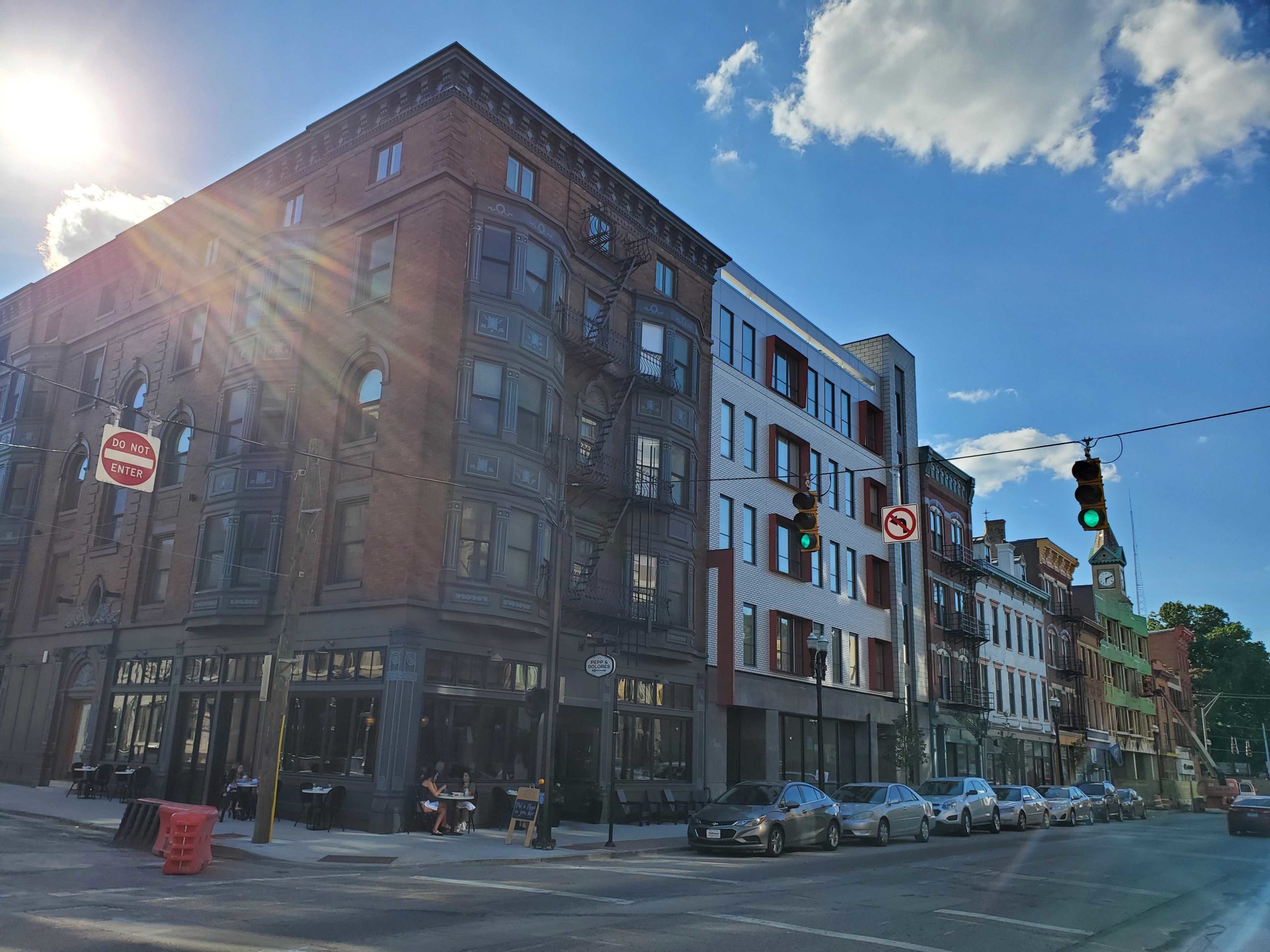
As a white male who has experienced deep privilege over the course of my life, it was important to educate myself on some of the history of the places we were passing through – particularly in the South. On our way from New Orleans to Atlanta, we made several stops at Civil Rights landmarks in places like Meridian, Mississippi and the Birmingham Civil Rights National Monument. The latter is home to an array of powerful statues and plaques commemorating the events of May 3rd, 1963, when top cop “Bull” Connor ordered his men to attack peaceful protesters and children with dogs, water cannons, and more. This was a horrific milestone and a turning point in the 1960s Civil Rights movement when images were published in the New York Times the following day. We also visited the tomb of Dr. Martin Luther King, Jr. and Coretta Scott King, which is located in “Sweet Auburn,” the neighborhood of Dr. King’s youth, and explored the National Center for Civil and Human Rights in downtown Atlanta, which powerfully linked Civil Rights history with the global inequities and injustices of the modern age. It was rather shocking how much of the history I had not been taught in class, and how much the framing of what I was taught differed from many of the personal accounts documented across these places of power.
Native American and Indigenous history was also a throughline of the trip, but it is deeply dismaying to see the lack of government recognition of the extermination and displacement of Native people across the country. It was particularly frustrating to see the vast majority of the items for sale in National Park gift shops being from non-Native sources. As we traveled from Detroit to Chicago, we stopped in Western Michigan to meet up with an old friend of my father who is an Elder in the Potawatomi Tribe of the Great Lakes area. We visited his Tribe’s highly successful casino and learned about how Tribes interact with the Federal government – gaining a deeper understanding of how tribal relationships with the Feds remain fraught, even today. It was a privilege to travel and learn this firsthand.
I haven’t processed the totality of my road trip experience, but it has given me a fresh layer of perspective on the work of Valley Vision and our many partners – including many of you reading this today. Your work and my work to make communities more livable is what it’s all about. We are attempting to solve the messy problems of our age, and doing it with a reverence for the past but also an excitement for what is to come. The desire to achieve this balance, while continuously learning and building trust, provides the energy and motivation to keep doing consistently challenging and sometimes thankless work to better our communities. We’ll continue to find our sweet spot as we collaborate on bold solutions that improve people’s lives – I hope you will too!
To keep up with Valley Vision’s work to advance livability in the Sacramento region, subscribe to our Vantage Point email newsletter!
Adrian Rehn is a Valley Vision Project Leader overseeing the Cleaner Air Partnership, Sacramento Neighborhoods Activating on Air Quality, and Valley Vision’s online communications. He can be reached at adrian.rehn@valleyvision.org.
Hybrid Work: The Disruption of 2021

With June 15th passing this week, marking California’s first opening since the pandemic hit, returning to the office and creating hybrid work environments is front of mind for many employers and employees. Microsoft Worklab published a recent report on hybrid work as the next big disruption – what are the big trends, how are they playing out in our region, and where do we go from here?
1. Flexible work is here to stay
Many workers got to experience remote work for the first time and don’t want to leave the positives of the experience behind. Nationwide, 70% want to retain a hybrid model although many are also clamoring for in-person time with their teams. In our region, the COVID-19 Resilience Poll tells us that 63% of workers worked full-time in office before the pandemic but 69% want a hybrid model now to avoid commutes and maintain more flexible hours.
2. Leaders need increased connection to workers
A recent study shows that business leaders are faring better than their employees throughout the pandemic with 61% saying that they are thriving while only 38% of those without decision-making authority say the same. Further, disparities in pandemic impacts are contributing to a divide – younger workers, workers of color, and women have struggled through the pandemic more intensely than others and are less likely to be in leadership roles at work.
3. High productivity is masking an exhausted workforce
Anecdotally, companies are reporting high productivity this year with commute, travel time and distractions of the office eliminated. Microsoft data shows that chats, emails, meetings, and time spent in documents have significantly increased between February 2020 and February 2021. It also shows that 54% of workers feel overworked and 39% feel exhausted. Digital overload and increased isolation are seriously taxing workers.
4. Gen Z is at risk and will need to be re-energized
Gen-Z, or those between 18-25 years old, are feeling these effects the strongest. 60% of Gen Z are merely surviving or flat-out struggling right now. This age demographic reports struggling to get new ideas on the table, get a word in during meetings, and feel excited or engaged about work. Because they are younger, often single, early in career, and less financially stable – isolation, network connections, and meaningful engagement has been much harder during the pandemic. The COVID-19 Poll found that in our region these factors and others contributed to higher rates of stress, anxiety, and depression for our younger respondents.
5. Shrinking networks are endangering innovation
The pandemic shrunk our worlds – both personally and professionally. Research shows that interactions with our close networks increased while our interactions with our more distant networks decreased. This reduces the inflow of new ideas, stifling innovation.
6. Authenticity will spur productivity and wellbeing
2020 was the year that home life was made visible at work – children, pets, and personal spaces came with many of us to our virtual meetings and as a result we had the opportunity to see each other as full humans in ways that never came through in routine office life. Additionally, our shared vulnerability of going through a tough time together bonded co-workers in new ways.
7. Talent is everywhere in a hybrid work world
The pandemic accelerated the notion that we can work from anywhere – and that is exactly what many workers want to do. A study from LinkedIn reports that remote job postings increased five-fold and 46% of workers say they want to move this year, anticipating continued remote work opportunities. Remote work can increase access to job opportunities for underrepresented groups – the same study found that women, Gen-Z, those without a graduate degree are more likely to apply for remote work and women, Black, and Latino workers are more likely than white men to prefer remote work. People are at inflection points in their careers with 41% noting that they’d like to leave their job within the year. In Sacramento County, 40% of jobs are remote eligible by function, as reported by the Bay Area Council Economic Institute. Additionally, the trend is that people in high cost areas are moving to lower cost areas – translating to an influx of Bay area residents to our region, a spike in real estate prices and growth in our professional workforce.
The trends are clear – we are in the midst of major disruption and transition to different ways of doing work. There are some clear recommendations for both employers and the region at large:
Empower workers to be able to work in office or remote environments: a mix of both will result in flexibility, productivity, and increased connection and collaboration. Just as employers pivoted to remote, now is the time to pivot again to safely open offices and create a new type of environment that embraces hybrid work where possible. Solutions should address technology tools, office design, home accomodation, and policy practices that maximize hybrid options.
Combat digital exhaustion starting from the top: Leaders need to understand the challenges of workers and actively promote a culture that encourages strong work/life boundaries and downtime. Organizations and companies need to strengthen diversity, equity, and inclusion practices and policies to address the intersectional burdens that people of color and other underrepresented groups face at work.
Rebuild our collaborative fabric: Isolation and smaller networks have marked 2020 and 2021 so far. Expanding networks, building collaborative opportunities and environments, and reacquainting with more distant networks (slowly for introverts!) will be a key activity of 2021.
Enhance employee experience to attract talent: While workers are reconsidering career, location, and the opportunity landscape, employers must cultivate a diverse, inclusive, and flexible culture to attract top talent.
By maximizing the positives of the remote work experiences that we have experienced while mitigating the isolation and digital overload of the past year, 2021 is an opportunity to build stronger, more resilient organizations and businesses to support a trhiving, healthy, and innovative workforce.
To keep up with Valley Vision’s work to advance livability in the Sacramento region, subscribe to our Vantage Point email newsletter!
Evan Schmidt is Valley Vision’s Chief Executive Officer.
Skills for a Ready Future Workforce

Valley Vision has been examining Future of Work trends for many years. Our latest research was made possible through funding from the City of Sacramento CARES COVID Relief and in partnership with Burning Glass Technologies. This analysis sought to answer the question, where should resources be targeted to provide the most effective skills acquisition and training, especially to disproportionately impacted community members, to enhance and accelerate recovery from the pandemic.
Building on previous work, Automation Risk for Jobs in the Capital Region (March 2020) report looking at the potential impacts of automation in our nine county region, recovery from the pandemic and future workforce development strategies need to be responsive to multiple factors including:
• Meeting current and projected job needs
• Reducing future risk of automation/obsolescence
• Improving job quality (higher wages, benefits and career advancement opportunities)
• Improving equity for communities of color, women and underserved groups
The following white paper highlights the result of these efforts:
To keep up with Valley Vision’s work to advance a future-ready workforce in the Sacramento region, subscribe to our 21st Century Workforce email newsletter!”
Renee John is a Valley Vision Project Leader managing initiatives within the 21st Century Workforce impact area.
New Study of Region’s Food System – and Prevailing Gaps – to Launch
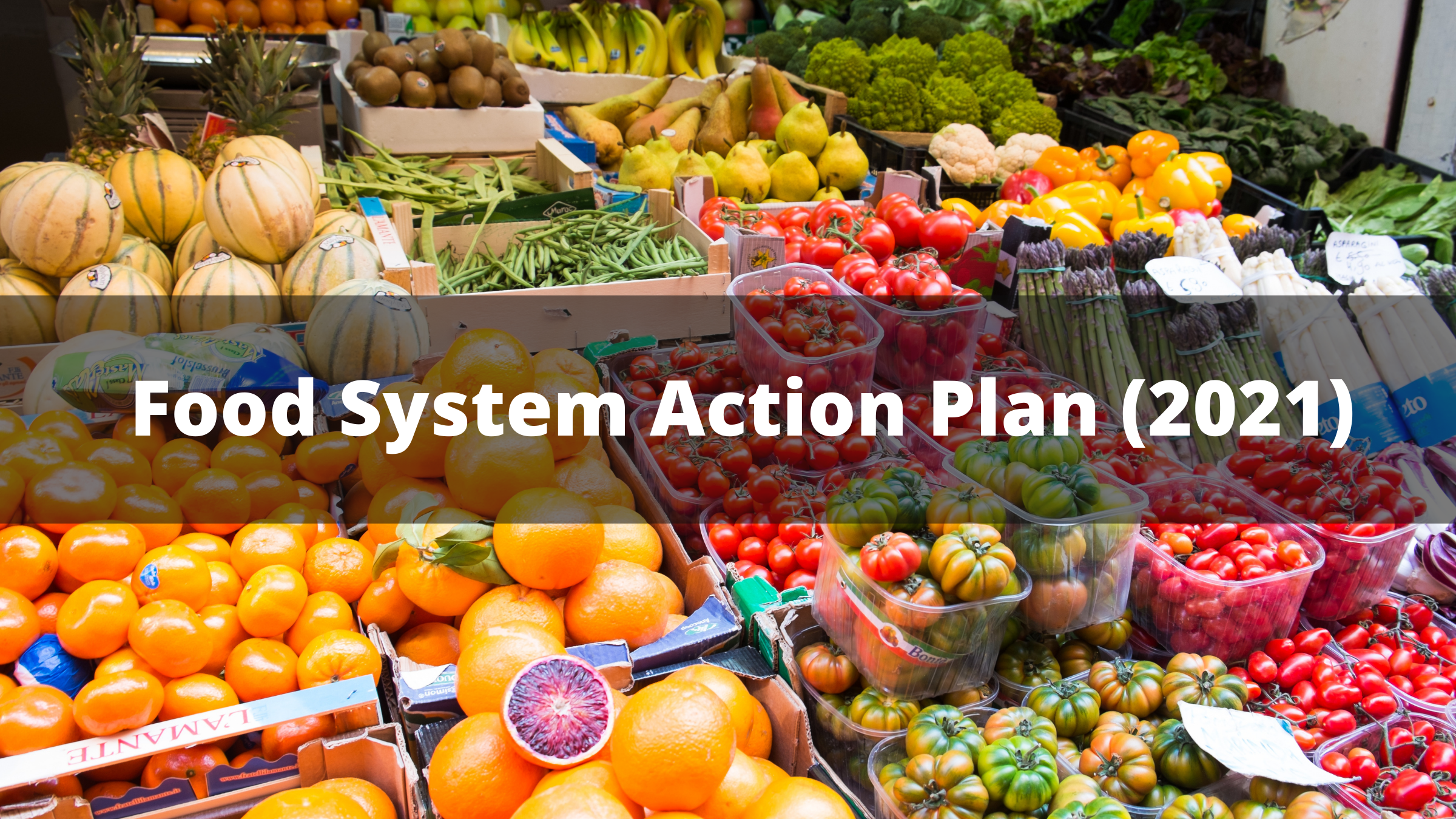
SACRAMENTO, CA – MAY 19, 2021: The Sacramento Region Community Foundation (Foundation) and Valley Vision announced today a new research study being jointly launched on the region’s food economy and prevailing gaps in the greater Sacramento region’s food system. The research will inform recommendations for investment strategies to strengthen the region’s food system capacity and resiliency.
“The region’s food system is dynamic and complex,” said Linda Cutler, CEO of the Sacramento Region Community Foundation. “While the overall food economy has advanced in recent years through dedicated efforts like new job creation, workforce programs, institutional procurement, and food literacy, disparities persist around food access, security, and system capabilities that have been further exacerbated by the COVID-19 pandemic.”
The study will build upon earlier work highlighted in the Sacramento Region Food System Action Plan (FSAP), a seminal study conducted by the Foundation in partnership with Valley Vision in 2015. The FSAP laid the building blocks for a regional roadmap and identified an actionable role for the Foundation that it has worked to implement since.
Valley Vision conducts public opinion polls in partnership with the Institute for Social Research at Sacramento State and will field this new poll in June to collect data on residents’ experiences, perceptions and needs related to accessing food. The Food System poll, in addition to other engagement and data inputs, will provide the Foundation with invaluable information that will be used to update the 2015 FSAP.
“The ultimate goal of this research is to ensure the viability of the food and ag economy at all scales,” said Valley Vision CEO Evan Schmidt. “This includes increasing the amount of locally grown food distributed within the regional food system, increasing access to fresh, affordable produce, especially in underserved communities, and increasing consumption of healthy foods through access to nutrition education.”
The research findings will support meaningful collaborations among food system partners and improve alignment of system activities and investments. Findings will also help identify compelling short- and longer- term priorities and establish a baseline for future progress.
“This is incredibly important work for our region,” said Kate Stille, Sacramento Region Community Foundation Board Chair and Chief Impact Officer for Nugget Markets, Inc. “We can point to real and tangible results born out of the 2015 FSAP, which has dramatically improved food security in underserved communities by strengthening the emergency food distribution network.” The 2015 FSAP inspired a partnership between the Foundation and Sacramento Food Bank & Family Services to form the Neighborhood Food Access Networks, which today serve hundreds of thousands of people by networking together more than 200 emergency food distributors across Sacramento neighborhoods.
The work to strengthen the food system is all-the-more critical given the COVID-19 pandemic, which greatly impacted health and economic disparities in the local community. High unemployment has increased the level of need for food. Local food banks, schools, restaurants, and many others have created new distribution mechanisms to respond to the crisis. The FSAP is a blueprint for action that will help shape these types of strategic initiatives, as well as to inform local leaders and the community on how to engage in meaningful solutions and catalyze investments in our vital food system.
“A systems approach centered on equity is needed,” said Schmidt. “Understanding food access and security issues is paramount to ensuring a health-promoting and accessible food system that can serve the needs of those who live in the region as well as those who benefit from our rich agricultural valley nationally and globally.”
The public opinion poll will go into the field in June and findings are expected to be published in September.
###
About the Sacramento Region Food System Action Plan (FSAP): FSAP was a seminal study conducted by the Foundation in partnership with Valley Vision in 2015 and provided a common framework along with integrated goals, strategic priorities, and recommended actions to strengthen the food system for the region. Intended to serve as a roadmap for food system development, function, and investment, the FSAP identified several disconnects in the food system, including the gaps between great food abundance and a vibrant economic sector, high levels of food insecurity, poor food-related health outcomes, and missed opportunities for local food sourcing and markets.
About the Sacramento Region Community Foundation: For over 35 years, the Sacramento Region Community Foundation has been the capital area’s trusted steward of charitable assets and champion for impactful philanthropy. The Foundation’s mission is to transform the capital area through focused leadership and advocacy that inspire partnerships and expand giving.
About Valley Vision: For more than 25 years Valley Vision has used research to help governments, businesses, foundations and community groups better understand the issues facing our region. We believe that knowing and understanding the facts is the best way to establish a common working foundation for collaborative problem-solving. That’s why Valley Vision conducts, produces and interprets research including scientific public opinion polls, focus groups, community needs assessments, best practice studies and other research tools to bring to light the information local leaders need to improve our communities.
COVID-19 Imposed Inequitable Hardships on People of Color and Younger Adults, Latest Public Opinion Poll Reveals
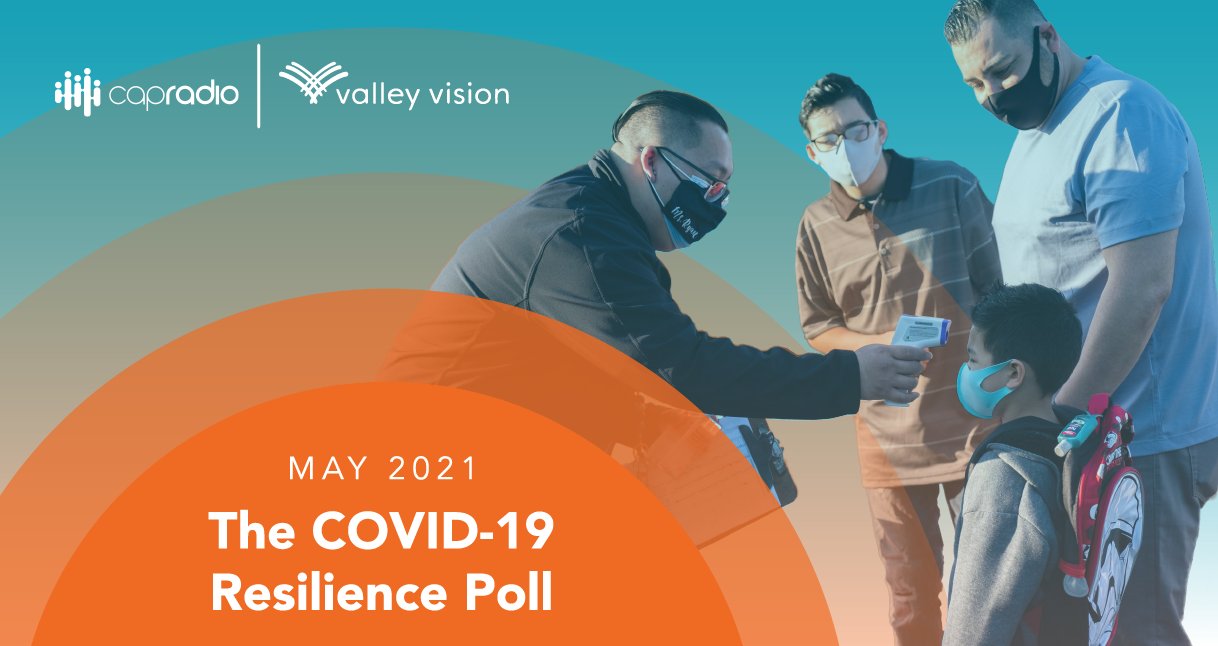
Sacramento, CA – May 10, 2021: Three public opinion polls fielded through a year of the COVID-19 pandemic from May 2020 to March 2021 revealed that the health crisis had a significant impact on the financial and emotional well-being for many. Communities of color, those earning less, and those who are younger, have been more severely impacted than others, experiencing greater income loss, more difficulty affording basic necessities, and deeper fears and concerns about financial security and mental health.
Valley Vision and CapRadio released today the third and final COVID-19 Resilience Poll, which was fielded by the Institute of Social Research (ISR) at Sacramento State between March 12-29, 2021. The research is demographically representative of the Capital region, encompassing Sacramento, El Dorado, Placer, Sutter, Yolo, and Yuba counties, with a margin of error of +/- three percent.
“The latest report highlights clear themes that emerged from polling over a year of the pandemic.” said Valley Vision CEO Evan Schmidt. “The impact is expected to be felt for years to come and will likely signify historic shifts in our social, political, and economic landscape. The findings point to the unique challenges our region now faces and where we most need to focus system change to build an equitable recovery.”
The research findings show the greatest hardships were felt by vulnerable communities. In the most recent poll, 41% of respondents overall reported a loss of income during the pandemic. For Black, Hispanic, and Asian/NHPI respondents, that number is much higher.
“The three surveys in the past year make it clear that vulnerable communities feel even more vulnerable because of the pandemic,” said Nick Miller, managing editor of news and information at CapRadio. “Our journalists will be looking deeply at these issues on CapRadio this week.”
These findings are consistent with what is taking place across the United States. A study conducted by the Pew Research Center in April 2020 found that 26% of middle-income adults and 53% of lower income adults could not pay their bills in full that month. Only 23% of lower income adults and 48% of middle-income adults reported having “rainy day funds” that would cover expenses for three months in case of an emergency, compared to 75% of higher income adults.
“In addition to the toll taken on lives, overall well-being, and jobs, one constant throughout the pandemic has been the rapid-response system transformation,” Schmidt said. “Valley Vision and CapRadio publicize these findings to help local leaders shape future social, civic, and economic structures to help make all of our communities inclusive, supported, safe, and equitable.”
TOP COVID-19 RESILIENCE POLL LEAD FINDINGS:
Financial hardship: Communities of color, those earning less, and those who are younger experienced greater income loss, more difficulty affording basic necessities, and deeper fears and concerns about financial security.
- 54 to 61%of those with significantly reduced income couldn’t afford an adequate food supply throughout the year.
- 59 to 68% said they couldn’t afford rent or mortgage.
- 39 to 47% of 18- to 39-year-olds said they couldn’t afford to pay down debt.
Workplace: The circumstances of the pandemic spurred a seemingly ten-year acceleration of new workplace trends toward remote work, automation, and e-commerce.
- The percent of people who work from home either part or full time shot up from 38% prior to the pandemic to 70% during the pandemic.
- 78% said they want to work at home at least one day a week; 28% said that they want to work at home full time.
- By larger margins, 18- to 38-year-olds believe the pandemic has made them less employable due to concerns over availability of jobs, changes in their industry, and their skillset.
Mental and Emotional: The pandemic created significant increases in depression, anxiety and stress, concerns about substance use, and concerns about physical and emotional violence at home.
- The likelihood of experiencing stress or anxiety, or depression or hopelessness decreased as income level increased.
- 92% of Hispanic respondents reported feelings of stress or anxiety at least one day in the last seven days, followed by 85% of Asian/NHPI respondents, and 82% of Black respondents.
- Respondents who are white were least likely to have experienced these feelings (52%).
Education: A year of educating from home has been difficult on parents, students and teachers, with more than two-thirds of parents reporting concerns about their children falling behind academically.
- In May 2021, 79% of those with children said they were doing some kind of remote learning.
- 54% of parents were more likely to have lost income, compared to 34% of non-parents.
- 71% of parents reported being concerned about their ability to handle other responsibilities.
- 69% of parents said having children in school partly or fully remotely was negatively affected their ability to do their job.
Beyond COVID-19: The last poll found that vaccination skepticism is likely to impact our region, with 39% of respondents stating that they would probably not or definitely not get a COVID-19 vaccination when it becomes available to them.
- Black respondents were significantly more skeptical than other race/ethnicities, with 65% reporting they probably or definitely would not get a vaccine, compared to 44% of white, 29% of Hispanic, and 15% of Asian/NHPI respondents.
- 71% of respondents reported knowing someone who had COVID-19.
###
About the Polling Series Valley Vision and CapRadio, in partnership with the Institute of Social Research (ISR) at Sacramento State, conduct research via scientifically administered surveys of area resident attitudes. The survey data inform policy-makers and stakeholders on key regional issues by providing on-the-ground public engagement data. The approach used is highly effective and unique by establishing a scientifically valid and demographically representative panel of regional residents that reflects a microcosm of the region as a whole. The panel size is consistently about 2,000 people from six counties – Sacramento, Yolo, El Dorado, Placer, Yuba, and Sutter. The panel is weighted to demographically represent the region and each survey achieves a statistical valid margin of error of not more than +/- 3%.
About Valley Vision For more than 25 years Valley Vision has used research to help governments, businesses, foundations and community groups better understand the issues facing our region. We believe that knowing and understanding the facts is the best way to establish a common working foundation for collaborative problem-solving. That’s why Valley Vision conducts, produces and interprets research including scientific public opinion polls, focus groups, community needs assessments, best practice studies and other research tools to bring to light the information local leaders need to improve our communities.
About Sacramento State’s Institute for Social Research ISR supports community partners in improving programs and policies in the region and throughout the state. Located at the university’s downtown location, the Institute offers a broad range of expertise conducting surveys and applied research. Since 1989, our collaborations with government agencies and nonprofit organizations have contributed to public accountability, program fidelity, and the strengthening of communities.
About CapRadio CapRadioserves California’s Capital Region, Central Valley and Sierra Nevada as the public-supported alternative to for-profit media. As the NPR-member station based in Sacramento, CapRadio connects with communities through seven broadcast stations, live streaming, podcasts, digital communities, live experiences and more. Known for its award-winning newsroom, CapRadio is recognized as a leader in community-engaged journalism and state government reporting, and CapRadio Music is the exclusive broadcast source of classical and jazz in the region. With more than 500,000 weekly listeners on-air and online, CapRadio provides a trusted and indispensable source of information, music and events.
“This Is Not Goodbye, But Thank You”
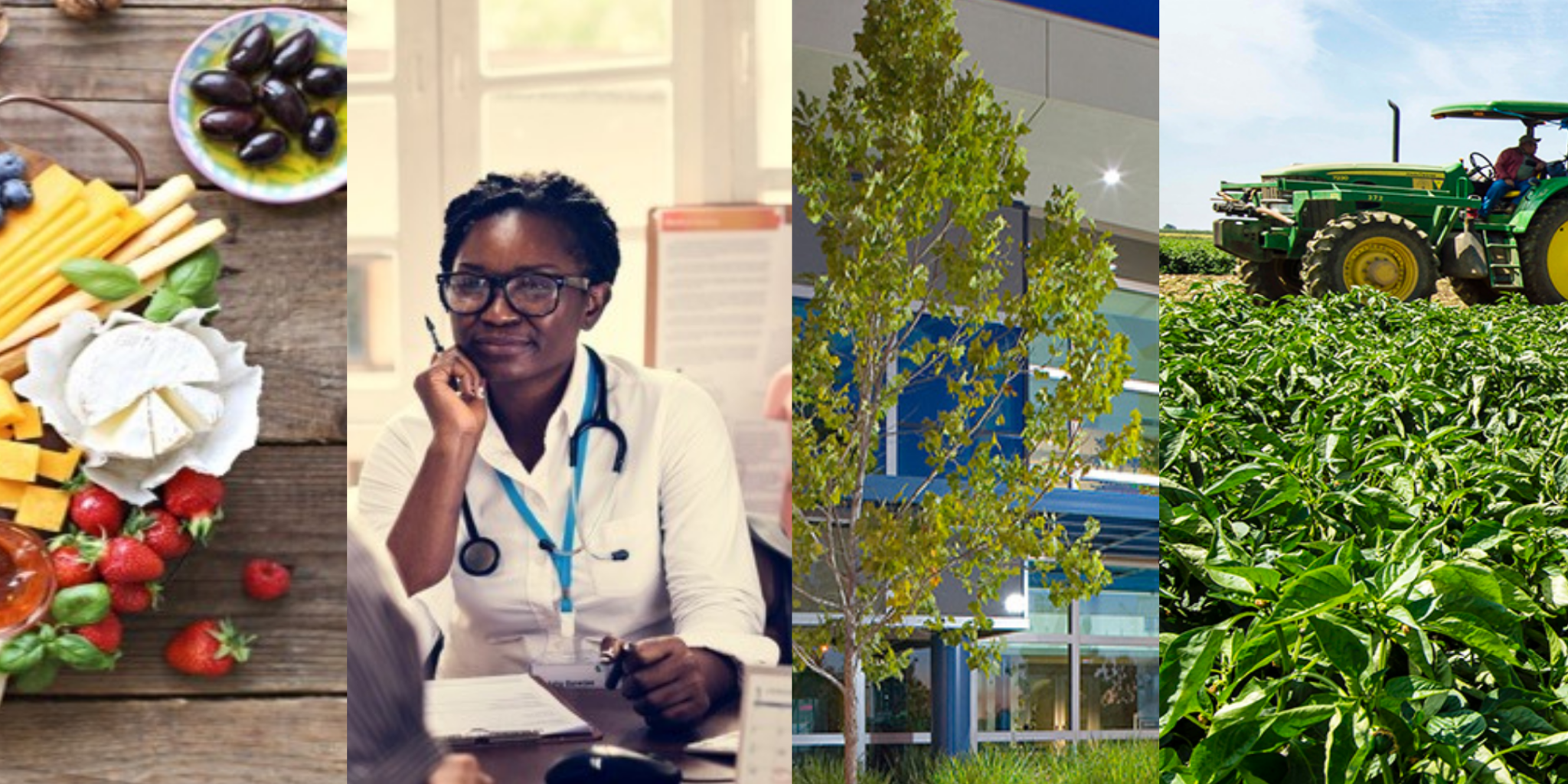
Being a part of Valley Vision was a turning point in my career. I have waded through non-profit jobs for most of my professional life, picking up different roles every year, finding new ways to expand my skills, but nothing ever felt “right.” After graduating from college, like many young adults, the degree that I spent so many years working to achieve, I thought, was a ticket to that “grown-up job.” The problem was, I had no idea what I wanted to do or what I was genuinely passionate about pursuing. I had spent so much time working to finish my education, I forgot to plan for the rest of my post-academic life.
As I floated in and out of the professional world, I juggled my interest in food systems, agriculture, and community development, trying to find ways to apply all this information I had in my brain to constructive use. I dabbled in the restaurant industry, farmer’s markets, marketing, event planning, university institutions, but nothing seemed to ever fit. Finding Valley Vision was like finding the light at the end of very long tunnel. This was an organization that had not just a fantastic reputation in civic engagement – and food systems – but had a leadership interested in developing and engaging with young professionals. I finally was in a space where I was treated as a qualified individual, and not as a nuisance, but a respected colleague.
Over the last three years, I was given opportunities far beyond what I ever expected, from managing the Farm to Fork Steering Committee to producing conferences like Future Focus to planning and organizing Valley Vision’s 25th Anniversary event. I engaged with regional and national leadership, developed real genuine relationships, had a voice at the table to help solve critical issues, helped provide solutions to issues I was passionate about, and learned about challenges facing communities not just here in the region, but throughout California.
I do not consider my departure from Valley Vision an ending. That is not the Valley Vision Way. Not only will the professional education I was afforded be long lasting, but the relationships built among my mentors and colleagues will be for a lifetime. I probably can never express how much appreciation I have for my time at Valley Vision, but I know that it is because of Valley Vision, its employees, its mission, and culture, that I have the confidence to move forward into this next chapter.
Emma Koefoed was a Valley Vision Project Manager staffing the Food & Agriculture Impact Area and leading Valley Vision event planning from 2017 until the end of 2020. She is the new Manager of Communications & Marketing at the SMUD Museum of Science & Curiosity.
2021: A Time for Courageous Action

January is often when we make predictions for what is to come in the new year. But, if 2020 taught us anything, it is that we are living in an unpredictable world. And given the tumultuous start to 2021, it is likely we won’t be sailing through smooth waters.
With upcoming transfers of leadership, still-record-breaking COVID-19 infection rates, an aggressive national vaccine roll out needed, and with economic recovery and the need for climate resilience at the forefront, we know the 2021 waters will be choppy. Throughout 2020 we talked about the need to reimagine systems that are resilient and equitable. Without courage to take on hard things and focus on tackling complex problems together, we will come out the other side of the pandemic only to recreate inequitable systems that don’t meet the needs of all and can’t adapt to rapid changes that occur in our modern world. Here are some foundational questions and bold ideas from outside our region to inspire us in 2021.
Economic Insecurity
Almost a year into the pandemic, our nation has lost tens of millions of jobs and while there will likely be additional support for small businesses with a new administration, economists have braced us for a slow recovery. Further, with rapidly accelerating changes to our economy and workplaces, many of the lost jobs may be gone permanently. We must push forward innovative and equitable solutions to help people re-enter the labor market. How do we address the dual challenge of the pandemic’s impacts on the economy and the rapidly changing and digitizing workforce? The Aspen Institute has launched a partnership with Mastercard Center for Inclusive Growth to modernize the structure of worker benefits. The program, Benefits21, reimagines a 21st century worker benefits system that provides financial security to all, with a focus on inclusive, portable, people-centric, and interoperable benefits, including unemployment insurance, paid leave, training, and retirement. Additionally, mayors from around the nation are exploring how Universal Basic Income could be a part of a solution to pandemic response and economic insecurity in their communities. Finally, close to home, the Stanislaus Cradle to Career Partnership drives a highly collaborative and robust campaign approach to align institutions to ensure that every child has a path, plan, and a purpose.
Racial Equity
2020 laid bare long term racial inequities and generated an increased sense of urgency to act. How do we move forward with racial equity as a central and driving force in community initiatives? The California Strategic Growth Council is working in collaboration with the Public Health Institute to support the Capitol Collaborative on Race & Equity (CCORE) – a racial equity capacity-building program for California State employees. The program offers cohorts for participants to receive training to learn about, plan for, and implement activities that embed racial equity approaches into institutional culture, policies, and practices. McKinsey offered a data report looking at the role of coalitions in advancing racial equity and W.K. Kellogg Foundation in partnership with Lever for Change is seeking proposals to close the racial equity gap so all children, families and communities can be more confident, healthier and secure in their trust of the systems and institutions that serve them. Registration is due January 28th.
Digital Divide
2020 also made clear the necessity of digital access for all. Over 20 million people across the U.S. lack broadband access- yet connectivity is required for education, jobs, and basic services. How do we rapidly transition infrastructure and services to reflect an economy that requires full digital access? The City of San José, in partnership with the City of San José Mayor’s Office of Technology and Innovation, has engaged the California Emerging Technology Fund to establish the Digital Inclusion Partnership, a $24 million cross-sector fund that will be distributed in grant awards over a ten-year period. It is the city’s largest philanthropic effort in recent history and aims to provide universal connectivity and appropriate digital skills to 50,000 households. This robust effort is a public private partnership and in its first round of rounding will disperse $1M to organizations in San José who are closing the Digital Divide through expanding device access and digital literacy skills.
Housing and Homelessness
Homelessness continues to rise, with a new report from L.A. projecting homelessness doubling by 2023. Additionally, housing affordability challenges have only worsened in 2020 as income loss has occurred and while evictions were avoided, the weight of accumulated rent payments will hit many in 2021. What are the solutions that will help us launch and scale efforts to address housing affordability and homelessness? In Portland, Oregon, Mercy Corps created the Community Investment Trust (CIT) creating a fund that builds the possibility to strengthen communities and create empowered lives. The CIT offers a long-term path to collective, communal ownership of real-estate for investors starting from $10-$100 per month. In Vancouver, the charity Foundations for Social Change (FSC), in partnership with the University of British Columbia gave individuals experiencing homelessness $5,800 with no strings attached and saw very positive outcomes including the attainment of stable, long term housing and food security.
Climate Change
Another aspect of 2020 has been the opportunity to decrease commuting and spend more time in nature for many. Further, COVID-19 response has showed us that we can have the will to move quickly to enact policies and practices for the good of public health. How will we take the lessons of pandemic response and translate them into gains in climate response and resilience? Many cities are taking rapid approaches to increase active transportation, addressing climate change and responding to increased demand for safe walking and biking infrastructure. Paris has demonstrated that cities can go green fast and enact changes that go beyond the pandemic, and Stay Healthy Streets Seattle shows ways that bike lanes are being utilized in ways that improve health and environment.
Addressing these foundational questions for 2021 and learning about initiatives from outside our region inspires us to think differently, take action in new ways, build new types of partnerships, and advance bold solution sets about complex community problems.
Valley Vision supports livable communities in the Capital region by advancing economic prosperity, social equity, and environmental sustainability. We use actionable research, policy education and advocacy, collaboration, and program activation to advance our work. Some key priorities in 2021 will be: enacting a regional agenda for digital inclusion, supporting inclusive economic recovery and growth through Our Path Forward: The Prosperity Strategy, advancing climate resilience, and supporting decision-making with actionable research. Our next Vantage Point will include a focus on inspiring action being taken within our region – there have been a significant amount of that too!
What inspires you for 2021? Let us act courageously together to advance equity, prosperity, and sustainability in our region and in our communities.
To keep up with Valley Vision’s work to advance livability in the Sacramento region, subscribe to our Vantage Point email newsletter!
Evan Schmidt is Valley Vision’s Chief Executive Officer.
What Are You Hopeful for in 2021?

A year of deep challenges has come to an end, and a new year is upon us. Read on for thoughts and predictions that Valley Vision staff hope will come to pass in 2021:
Meg Arnold: “I’m hopeful for transitions: swiftly, to vaccines; smoothly, to the new administration; happily, back to seeing people in person without worry, and (on a personal note) successfully, for the four young adults in our home who will all be starting or resuming their four-year degree programs in the fall.”
Isa Avanceña: “I’m hopeful for opportunities for our communities to come back stronger than ever. It won’t be easy, but I believe our region has what it takes. I’m also looking forward to lots of in-person quality time with family and friends, especially in the second half of the year.”
Kari MacDonald: “I am hopeful that we spend 2021 remembering what is truly important: health, love, family, work-life balance, using technology for connection, and good books!”
Houa Vang: “I am hopeful for great prosperity in health, compassion, and growth for everyone in 2021.”
Grace Kaufman: “I’m hopeful for continued health, colorful sunrises and sunsets, new friendships, and quiet reflection.”
Alan Lange: “Globally, I’m hopeful that everyone will take time to fully appreciate the good things that are in their lives. Personally, I’m hopeful that the deluge of house projects I’ve been assigned by my boss (aka spouse) over the past few months will slow so I can have a free weekend (Love you, K!).”
Evan Schmidt: “I’m hopeful for a better 2021 than 2020! This includes: health and well-being for all, the opportunity to create systems and communities that are better than what came before, the ability to visit family that lives long distance, and to go to a fun party by the end of 2021!”
Trish Kelly: “That 2021 sees restored health; economic recovery and renewal that is truly inclusive, starts to remediate past injustices and structural disparities, and sees our region leading around environmental innovations. And that we will be able to see and hug loved ones.”
Renee John: “I am hopeful we will all be kinder to each other, think of each other first and ourselves less.”
Jesse Flores: “I’m hopeful for the opportunities to channel built-up energy and motivation from 2020 towards a more racially equitable Sacramento region.”
David Espinoza: “I am hopeful to continue witnessing high-quality and affordable internet service expanding across the region. I am hopeful for good health and unity in the country and the world. I am hopeful to become better acquainted with the beautiful and amazing Greater Sacramento Region and for new adventures here with my family. Live long and connected, and may the broadband be with you.”
Adrian Rehn: “I hope for a better and brighter 2021 where people’s basic needs are provided for.”
To keep up with Valley Vision’s work to advance livability in the Sacramento region, subscribe to our Vantage Point email newsletter!
The Year In Broadband…

Broadband has long been recognized as indispensable to equity and economic development. In recent years, significant progress has been made to ensure statewide access. Still, over 8 million California residents do not have broadband subscriptions. We have a long way to go before broadband in California is truly ubiquitous.
In 2020, there has been accelerated momentum around the issue. The onset of the COVID-19 pandemic forced many Californians to pivot some of the most crucial elements of their life — work, school, healthcare, access to services — to an online setting. This shift is an urgent reminder that, in this day and age, broadband infrastructure and adoption is as crucial as roads or electricity.
Valley Vision works with counties, cities, anchor institutions, community groups, businesses, policymakers, and others to bridge the Digital Divide and promote equal access to technology. In 2020, this was embodied in our work contributing to state broadband policy, together with the California Broadband Council, California Forward, the California Emerging Technology Fund, and legislative leaders; our continued role as manager of the Connected Capital Area Broadband Consortium; and our management of the Sacramento Coalition for Digital Inclusion, among others. Broadband infrastructure and adoption is also identified as a high priority of the region’s Prosperity Strategy.
State-level highlights:
- Valley Vision worked closely with California Forward, the California Emerging Technology Fund, and regional broadband consortia to provide input on AB 14, the Internet for All Now Act of 2021. The Bill would authorize the ongoing collection of an existing surcharge on revenues collected by telecommunications providers from customers. The surcharge funds the California Advanced Services Fund, which provides rural and urban communities with infrastructure and other grants administered by the California Public Utilities Commission. This new legislation was announced by Assemblymember Cecilia Aguiar-Curry at the California Economic Summit during a panel on Bridging the Digital Divide, together with Senator Mike McGuire; Trish Kelly, Managing Director of Valley Vision; and Deputy Director Stephanie Tom of the California Department of Technology. Senator Lena Gonzalez introduced similar legislation — SB 4, the Broadband for All Now Act. Both legislators will be principal co-authors on each Bill. This is a major milestone and we hope for quick action in 2021.
- Valley Vision, in collaboration with the California Broadband Council and California Forward, facilitated input for the State’s Broadband Action Plan. An updated draft of the Plan was presented at the Broadband Council’s meeting on Thursday, December 17. The Plan provides a rich overview of the state of broadband across the State, a financial cost model for reaching all Californians with high-speed Internet, and many recommendations for action in 2021.
- Valley Vision co-led this year’s Ensuring Broadband For All working group at the California Economic Summit. The group’s efforts focused on increasing broadband access and adoption in both rural and urban areas. The group developed core principles to drive funding and policy solutions; encouraged collaboration on legislative solutions; supported the State Broadband Action Plan; and worked with the California Public Utilities Commission and others on innovative approaches to infrastructure investment, including leveraging federal resources.
Regional highlights:
- Valley Vision manages the Connected Capital Area Broadband Consortium. Funding for the Consortium was renewed by the California Public Utilities Commission in October 2019, for a three-year period. The Consortium is charged with engaging stakeholders to achieve the broadband connectivity goal of 98% of all households, assisting internet service providers in the region with their California Advanced Services Fund infrastructure grant applications, among other goals. In 2020, Digital Path and Frontier submitted a total of three applications to carry out broadband deployment in Sacramento, Sutter, and Yolo Counties. The Consortium will continue to work with incumbent, competitive, and new entrant internet service providers.
- Valley Vision, together with its partners, finalized and published the Sacramento Region’s Prosperity Strategy — the economic roadmap that ensures a strong, inclusive, and equitable economy. The Strategy calls out broadband infrastructure and adoption, including digital skills acquisition, as high priorities for the region, and was approved by the U.S. Economic Development Administration.
- Valley Vision is working with local government partners in Sacramento, Sutter, Yolo, and Yuba Counties to identify priority areas for broadband expansions or upgrades, including 5G. This includes generating an infrastructure and asset inventory in collaboration with the California Public Utilities Commission, the Sacramento Area Council of Governments, Caltrans, CENIC, the Sacramento Municipal Utility District, the Sacramento Housing and Redevelopment Agency, the Los Rios Community College District, Sacramento State, the City of Sacramento, the Sacramento Promise Zone, among others.
- Valley Vision, the California Emerging Technology Fund, and the Sacramento Area Council of Governments virtually co-convened broadband partners and stakeholders to discuss strategies for accelerating broadband infrastructure investments across the region. The event also showcased highlights of “Getting Connected,” a resource guide for local and regional government leaders featuring best practices, policies, and innovative models to catalyze infrastructure investment and adoption. The resource guide will be rolled out statewide in January 2021.
- Valley Vision put out a Business Broadband Service Survey to assess the current status of broadband service availability and subscription for businesses and community anchor institutions. Results from the survey will help determine and recommend improvements to broadband stakeholders, such as providers and local governments. Outreach for this survey will continue in 2021, through social media, newsletters, and outreach to business chambers.
- Valley Vision launched a campaign — via social media, its newsletters, and outreach to partners and stakeholders — around ground-truth testing of broadband speeds using the CalSPEED app. The app securely tests residential and mobile broadband speeds. Often, the speeds reported by internet service providers are not accurate. Information from the CalSPEED app creates an accurate assessment of actual broadband availability and adoption. Results are used to update the California Public Utilities Commission statewide coverage map and inform infrastructure investments. The campaign resulted in more than 500 CalSPEED tests in our Consortium region. It will continue throughout 2021.
- Valley Vision is completing its Preferred Scenario report for the region, in partnership with the California Emerging Technology Fund. The Preferred Scenario report identifies gaps in broadband deployment and access and the available local assets to address these gaps for the region’s Preferred Scenario corridor — the I -5 corridor. This corridor was identified through the Strategic Broadband Corridors project with Caltrans and the Sacramento Area Council of Governments. This report will identify strategies for leveraging investments.
- Valley Vision, in partnership with the University of California Agriculture and Natural Resources and the National Rural Telecommunications Cooperative, hosted a webinar focused on exploring innovative broadband infrastructure solutions, specifically the co-op model.
- The Federal Communications Commission announced the results of the Rural Digital Opportunity Fund Phase I auction. Winners in our Consortium region (Sacramento, Sutter, Yolo, and Yuba Counties) include Cal.Net, Geolinks, Frontier, LTD Broadband, and Space Exploration Technologies (Space X). Most locations will be receiving broadband with speeds of 100/20 Mbps, and gigabit-speed broadband. Click here to see the map.
Local highlights:
- Valley Vision is developing a Broadband Master Plan for Yuba County, in partnership with the County and Yuba Water Agency. The plan will be completed in the second quarter of 2021.
- Valley Vision is managing the Sacramento Coalition for Digital Inclusion, in collaboration with the city of Sacramento, the Sacramento Public Library, the Los Rios Community College District, California State University Sacramento, and Clear Strategies, among other community partners. The Coalition will be rolling out the 2021 Action Plan for broadband access, adoption, affordability, and digital inclusion and skills, including scale-up opportunities beyond Sacramento County.
- Valley Vision, in collaboration with the Delta Protection Commission, developed a broadband coverage report that will help to identify areas where service most needs improvement. This will empower community leaders and internet service providers to leverage existing opportunities for service expansion and upgrades, and to seek broadband deployment funding.
Valley Vision hosted a webinar on “Community Broadband in Yolo County,” in partnership with the Woodland Technology Alliance. The webinar was a conversation about the current state of the County’s technical infrastructure, as well as solutions to address the community’s broadband gaps. A full recording can be found here, and a summary of the discussion can be found here.
To continue staying up to date with all of the region’s broadband efforts, subscribe to Valley Vision’s e-Connect email newsletter!
Trish Kelly is Valley Vision’s Managing Director, leading its food, agriculture, workforce, and broadband initiatives.
David Espinoza is a Valley Vision Project Leader managing broadband projects and other initiatives in the Innovation & Infrastructure impact area.
Isa Avanceña is a Valley Vision Project Associate supporting the Board of Directors, and the Innovation & Infrastructure and Leadership and Civic Engagement Impact areas.